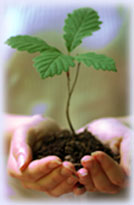 | |
|
Our lives,
so seemingly small, ripple out to the whole universe as tiny whispers like the sounds of butterfly wings, and the clear voice of the living truth. -J.L.D. |

The little wheatgrass farm is in production! Trays of fully grown grasses of wheat, barley, and oats, are being harvested, and trays of newly sprouting seeds provide a continuous supply of this precious juice. Wheatgrass juice is loaded with concentrated levels of chlorophyll, enzymes, amino acids, vitamins and minerals, and because of this, it's categorized as a superfood.
 We germinate the grass seeds in sprouting jars to get them going, then spread them evenly on top of one inch of organic soil.
We germinate the grass seeds in sprouting jars to get them going, then spread them evenly on top of one inch of organic soil.Then the grass seeds are covered with about 1/2 inch of soil which is patted down gently, and watered daily. Grass sprouts emerge in two days, and are ready for harvest in another 4-5 days. All in all, it's about one week from start to finish. How to sprout wheatgrass (or barley and oatgrass) Makes two 11"x11" trays Soak 1 pound of wheatgrass seeds for 8 hours in sprouting jar, covered well with pure water. Drain and rinse. Continue to rinse and drain twice daily until tails appear, about 1-2 days. We water the grass with purified water daily and watch the magic of life unfold before our eyes. Each day we harvest about 1/2 to one full tray, and keep new trays coming. After harvesting, the grass will have a second growth that takes about 5 days to grow. Each tray produces enough grass to make a total of 1 cup of juice, which is 8 ounces, or 8 servings. Once the grass is spent (after its second or maybe even third growth), we remove the root mat from the tray and place it in a special spot in our backyard. We wash the trays out, and begin the process again. The spent grass will compost in a few months, making rich new soil that can then be reused. (Until this happens, we have to purchase soil.) We use about 1 pound of grass seed to make two 11" x 11" trays. At the cost of $1.00 a pound for wheatgrass (when bought in 25 pound containers), the price for the juice is minimal—about fifty cents per tray. We purchase the best topsoil that we can find, because we don't have much extra good soil in our yard. We ordered eight 11"x11" trays and four 11"x22" drip trays, and a bottle of Saltwater Farms SeaCom PGR Liquid Kelp Fertilizer concentrate from The Sprout People, and 25 pounds of wheatgrass seeds from Wheatgrass Kits. With shipping included, the total was about $80. This is enough seed to grow 50 flats of wheatgrass, which will make 400 ounces for the cost of twenty cents per ounce. If we were to buy this at our local juice bar at $2.00 an ounce, the cost would be $800.00! To learn more about wheatgrass, you might enjoy reading Ann Wigmore's book, The Wheatgrass Book: How to Grow and Use Wheatgrass to Maximize Your Health and Vitality. We use a GreenStar juicer, however, we've made a lot of wheatgrass juice with this easy blender technique. A Little Story: Restoration When we were exhausted during the time my mother was dying last month, I harvested a patch of wheatgrass that was growing in one of our raised bed gardens. This little patch was an experiment to see how the grass would grow with lots of soil, and it grew beautifully. We juiced the wheatgrass and added the juice to a green smoothie, and the result was so dramatic. We were stunned—it was like having a blood transfusion! Our energy flooded back almost instantly. We've grown wheatgrass for juicing before, but in that moment it became very clear that we wanted to begin a wheatgrass blitz—to have enough trays growing so we could have wheatgrass juice every day for the whole month of June. And, hopefully by the end of the month, the cultivation of our little wheatgrass farm would be so easy, successful, and familiar, the practice would continue well into the future. 
The experiment of growing wheatgrass in the garden hadn't quite worked, mainly because of logistics. The grass grew well, but I wanted to water it with pure water. This meant lugging buckets from the kitchen where our water purifier was out to the garden, which was a time consuming and cumbersome process. It came to me that what we needed was to have the grass growing close to the kitchen for easy and fast tending and processing. There was a little square wood table that was on the front porch, and we got two pieces of 1 x 12" lumber and cut them to size. This made a simple tabletop that Rex screwed in place in minutes. We made the dimensions just the right size to hold six trays, but we should have made it big enough to hold eight, because that's what we need. The table was positioned right outside the kitchen door so we could easily water with purified water, rather than using the hose. Because of the proximity to the house, harvesting and tending has been so simple, and it's a pleasure to sit outside next to the grasses, watching them grow. We know that the chlorophyll and the tremendous nutrition in this food will be entering our bodies each day. We've read that wheatgrass juice is so powerful that it can break down anything in the body that is unhealthy, and then rebuild the body with strength and vigor. Seeing the beauty of the dewdrops on the tips of the blades reminds us of a wondrous fairyland, and there's just something about the beauty in the grass that makes our hearts sing. Each time we have the juice, the feeling of restoration comes flooding in. For us, this grass is a small miracle, humble as the earth, and as powerful as the heavens!  |









